SIU Director’s Report - Case # 17-TVI-269
Warning:
This page contains graphic content that can shock, offend and upset.
Contents:
Mandate of the SIU
The Special Investigations Unit is a civilian law enforcement agency that investigates incidents involving police officers where there has been death, serious injury or allegations of sexual assault. The Unit’s jurisdiction covers more than 50 municipal, regional and provincial police services across Ontario.
Under the Police Services Act, the Director of the SIU must determine based on the evidence gathered in an investigation whether an officer has committed a criminal offence in connection with the incident under investigation. If, after an investigation, there are reasonable grounds to believe that an offence was committed, the Director has the authority to lay a criminal charge against the officer. Alternatively, in all cases where no reasonable grounds exist, the Director does not lay criminal charges but files a report with the Attorney General communicating the results of an investigation.
Information restrictions
Freedom of Information and Protection of Personal Privacy Act (“FIPPAâ€)
Pursuant to section 14 of FIPPA (i.e., law enforcement), certain information may not be included in this report. This information may include, but is not limited to, the following:
- Confidential investigative techniques and procedures used by law enforcement agencies; and
- Information whose release could reasonably be expected to interfere with a law enforcement matter or an investigation undertaken with a view to a law enforcement proceeding.
Pursuant to section 21 of FIPPA (i.e., personal privacy), protected personal information is not included in this document. This information may include, but is not limited to, the following:
- subject officer name(s)
- witness officer name(s)
- civilian witness name(s)
- location information
- witness statements and evidence gathered in the course of the investigation provided to the SIU in confidence and
- other identifiers which are likely to reveal personal information about individuals involved in the investigation
Personal Health Information Protection Act, 2004 (“PHIPAâ€)
Pursuant to PHIPA, any information related to the personal health of identifiable individuals is not included.
Other proceedings, processes, and investigations
Information may have also been excluded from this report because its release could undermine the integrity of other proceedings involving the same incident, such as criminal proceedings, coroner’s inquests, other public proceedings and/or other law enforcement investigations.
Mandate engaged
The Unit’s investigative jurisdiction is limited to those incidents where there is a serious injury (including sexual assault allegations) or death in cases involving the police.
“Serious injuries†shall include those that are likely to interfere with the health or comfort of the victim and are more than merely transient or trifling in nature and will include serious injury resulting from sexual assault. “Serious Injury†shall initially be presumed when the victim is admitted to hospital, suffers a fracture to a limb, rib or vertebrae or to the skull, suffers burns to a major portion of the body or loses any portion of the body or suffers loss of vision or hearing, or alleges sexual assault. Where a prolonged delay is likely before the seriousness of the injury can be assessed, the Unit should be notified so that it can monitor the situation and decide on the extent of its involvement.
This report relates to the SIU’s investigation into the serious injury sustained by a 60-year-old woman in a motor vehicle collision on September 21, 2017.
The investigation
Notification of the SIU
At approximately 5:00 p.m. on Thursday, September 21, 2017, the Toronto Police Service (TPS) notified the SIU of the Complainant’s injury. The TPS reported that police officers were surveilling a vehicle in which the Complainant was a passenger. The officers tried to box the vehicle in and the vehicle fled, striking a light pole. The Complainant was injured as a result.
The Team
Number of SIU Investigators assigned: 3
Number of SIU Forensic Investigators assigned: 2
Complainant:
60-year-old female, declined to be interviewed or to consent to the release of her medical records.
Civilian Witnesses
CWÂ #1 Interviewed
CWÂ #2 Declined to be interviewed on the advice of Counsel
CWÂ #3 Declined to be interviewed on the advice of Counsel
CWÂ #4 Declined to be interviewed on the advice of Counsel
Witness Officers
WOÂ #1 Interviewed, notes received and reviewed
WOÂ #2 Notes reviewed, interview deemed not necessary
WOÂ #3 Notes reviewed, interview deemed not necessary
WOÂ #4 Notes reviewed, interview deemed not necessary
WOÂ #5 Notes reviewed, interview deemed not necessary
WOÂ #6 Notes reviewed, interview deemed not necessary
WOÂ #7 Notes reviewed, interview deemed not necessary
WOÂ #8 Notes reviewed, interview deemed not necessary
WOÂ #s 2-7 were not interviewed as they had limited involvement, but their notes were reviewed and summarized. WOÂ #8, who authored the collision reconstruction report, was not interviewed as his observations are contained in the report.
Subject Officers
SOÂ #1 Interviewed, notes received and reviewed
Incident narrative
On Thursday, September 21, 2017, the TPS Mobile Support Unit (MSU) was conducting surveillance of a gold coloured Chevrolet Equinox vehicle in the Eglinton Avenue East and Bayview Avenue area of the City of Toronto, in relation to a homicide investigation. The MSU conducted a high risk takedown of the vehicle by boxing it in with surveillance vehicles on Eglinton Avenue East near Laird Drive. The Equinox evaded the box and fled west on Eglinton Avenue East colliding with a light pole at Rumsey Road and Eglinton Avenue East. The driver and a rear passenger exited the vehicle and fled the scene. The front passenger side airbag deployed and the Complainant, who was the front seat passenger in the motor vehicle, was transported to hospital. When police followed the route taken by the fleeing occupants of the motor vehicle, a discarded firearm was located in a nearby dumpster.
Nature of Injury/Treatment
The Complainant was admitted to hospital where she remained for some time. Due to her refusal to consent to the release of her medical records, or to speak with investigators, the nature of her injures or subsequent treatment could not be determined.
Evidence
The Scene
The location of the collision was the southwest corner of Eglinton Avenue East and Rumsey Road in the City of Toronto.
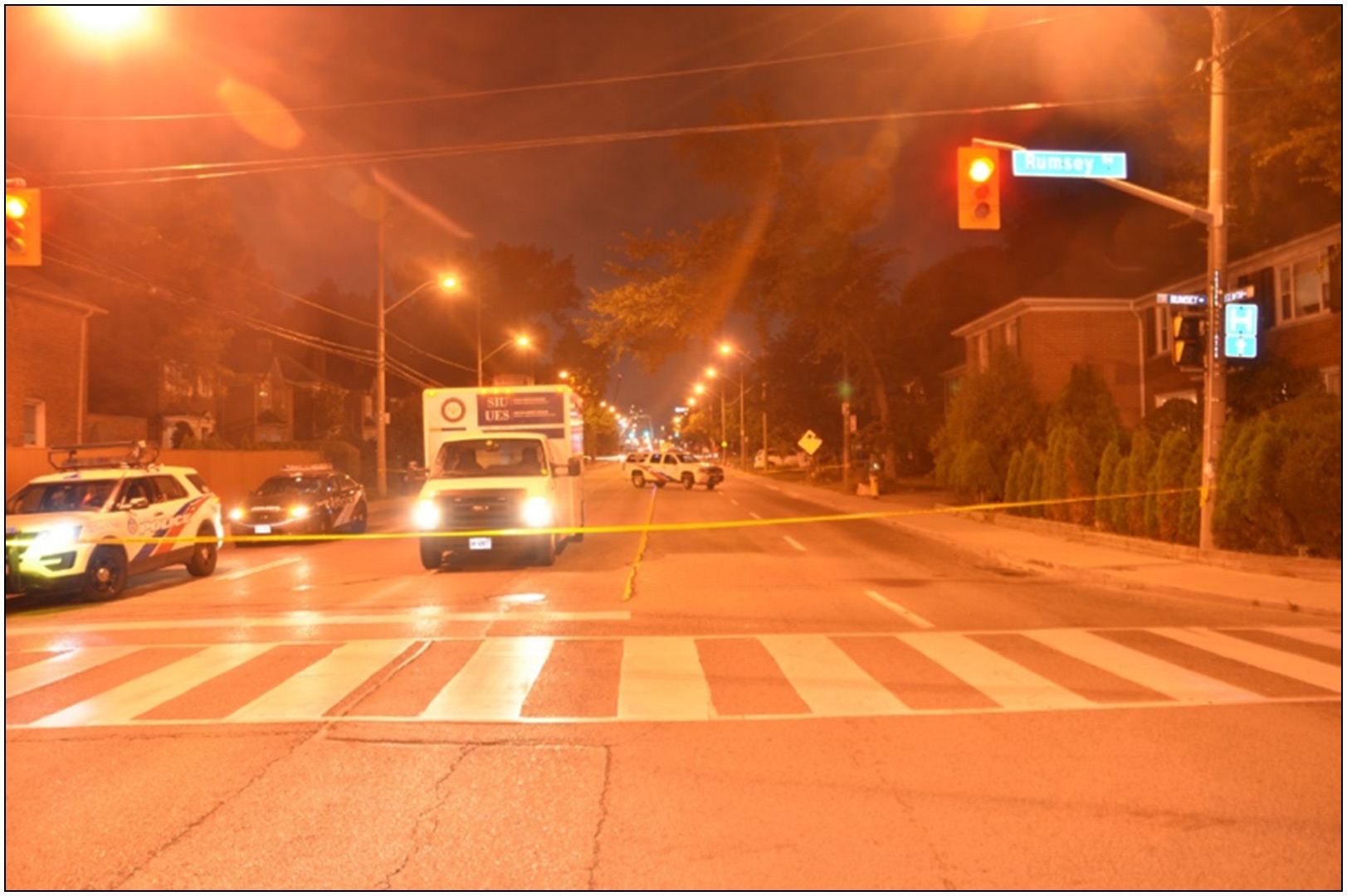
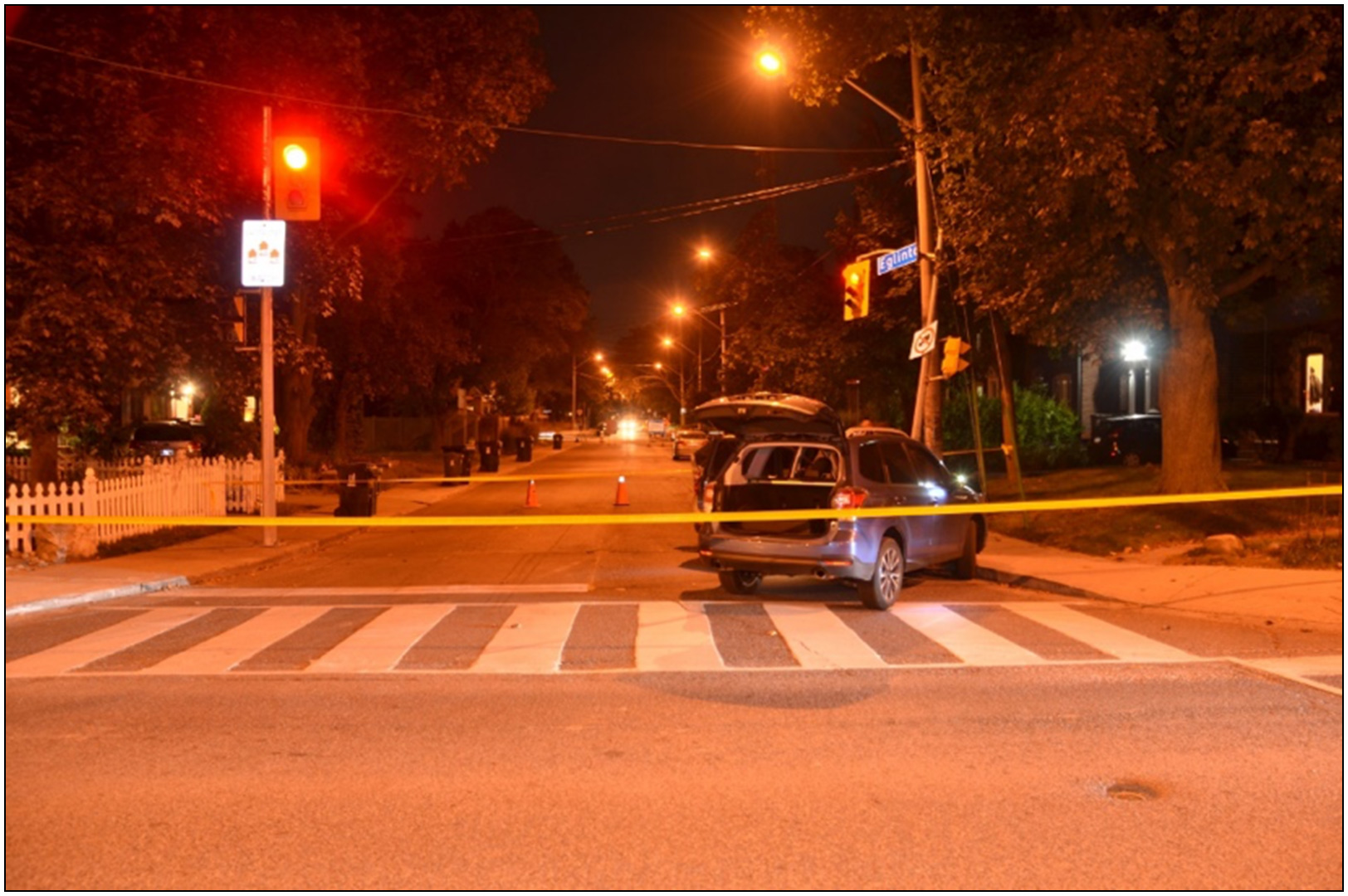
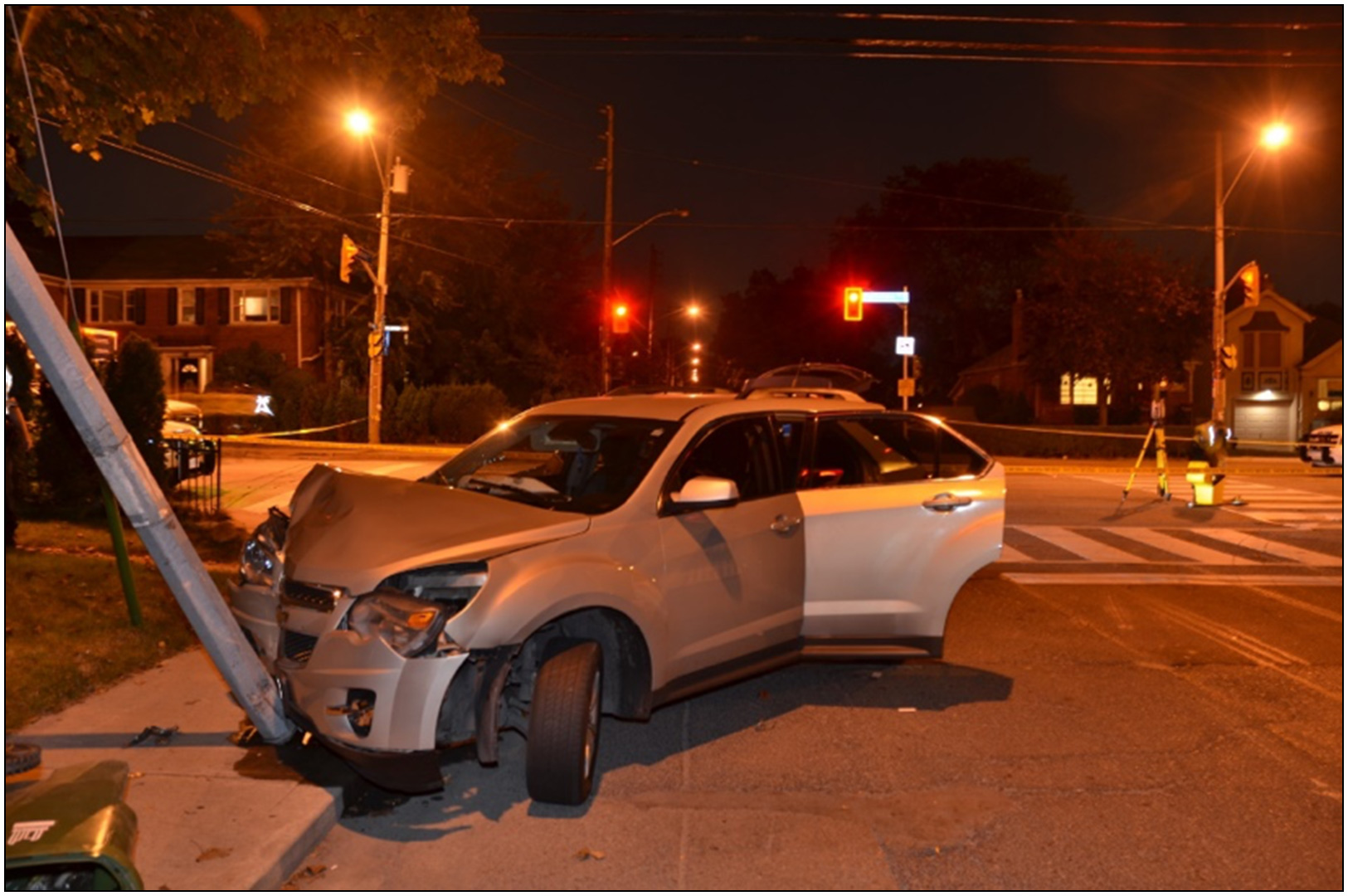
Scene Diagram
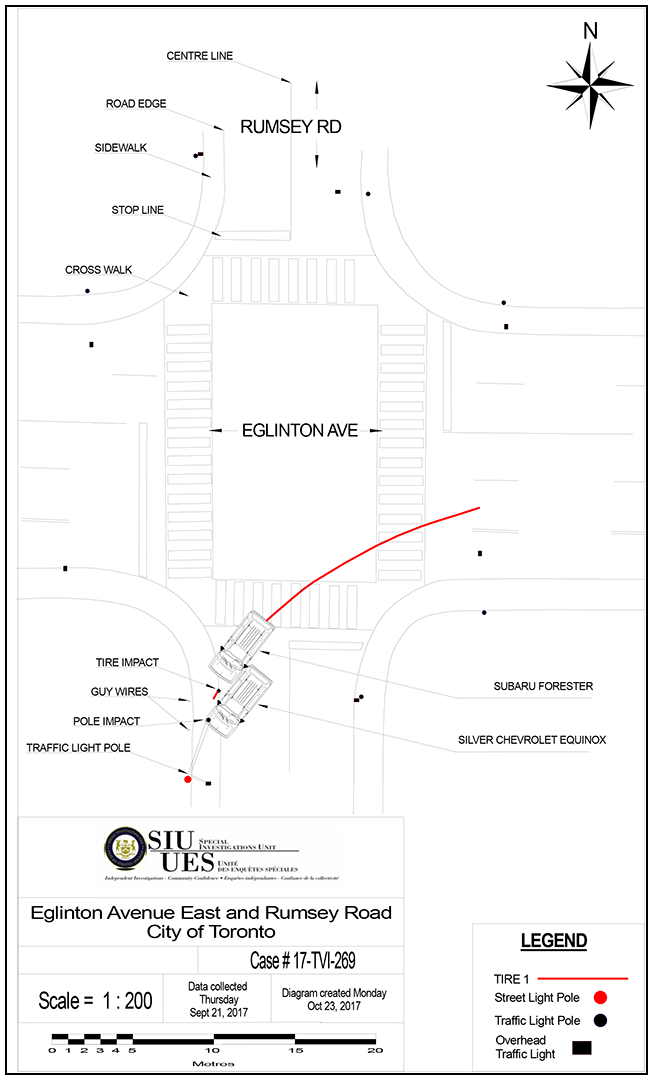
Forensic Evidence
No submissions were made to the Centre of Forensic Sciences.
Expert Evidence
The SIU Reconstructionist’s assessment of the collision yielded the following conclusions:
- According to the motor vehicle collision report, an unknown person operated a Chevrolet Equinox westbound on Eglinton Avenue East in Toronto, Ontario. The Complainant, 60 years of age, was seated in the front passenger seat, CW #3, 20 years of age, was seated in the left rear seat and CW #2, 20 years of age, was seated in the right rear seat
- It was warm, the atmosphere was clear and the roads were dry
- The critical curve speed for a motor vehicle to turn left from the passing westbound lane of Eglinton Avenue East to the southbound lane of Rumsey Road is 37 to 42Â km/h
- It is assumed that two tire marks starting on the middle eastbound lane of Eglinton Avenue East and curving to each vehicle, were in fact yaw marks[1]
- In excess of the critical curve speed, the unknown driver made a left turn to travel southbound on Rumsey Road but the Equinox went out of control into yaw, mounted the west sidewalk of Rumsey Road then came to rest with its front end lodged against a traffic signal pole on the west side of Rumsey Road just south of Eglinton Avenue East
- The frontal airbags of the Chevrolet Equinox deployed
- The traffic signal pole was consequently pushed to the southwest
- A short time later a Subaru SUV driven by the SO followed a similar path to the Chevrolet Equinox, southbound from the middle westbound lane of Eglinton Avenue East, resulting in the front end coming into collision with the partially open right rear door of the Chevrolet Equinox
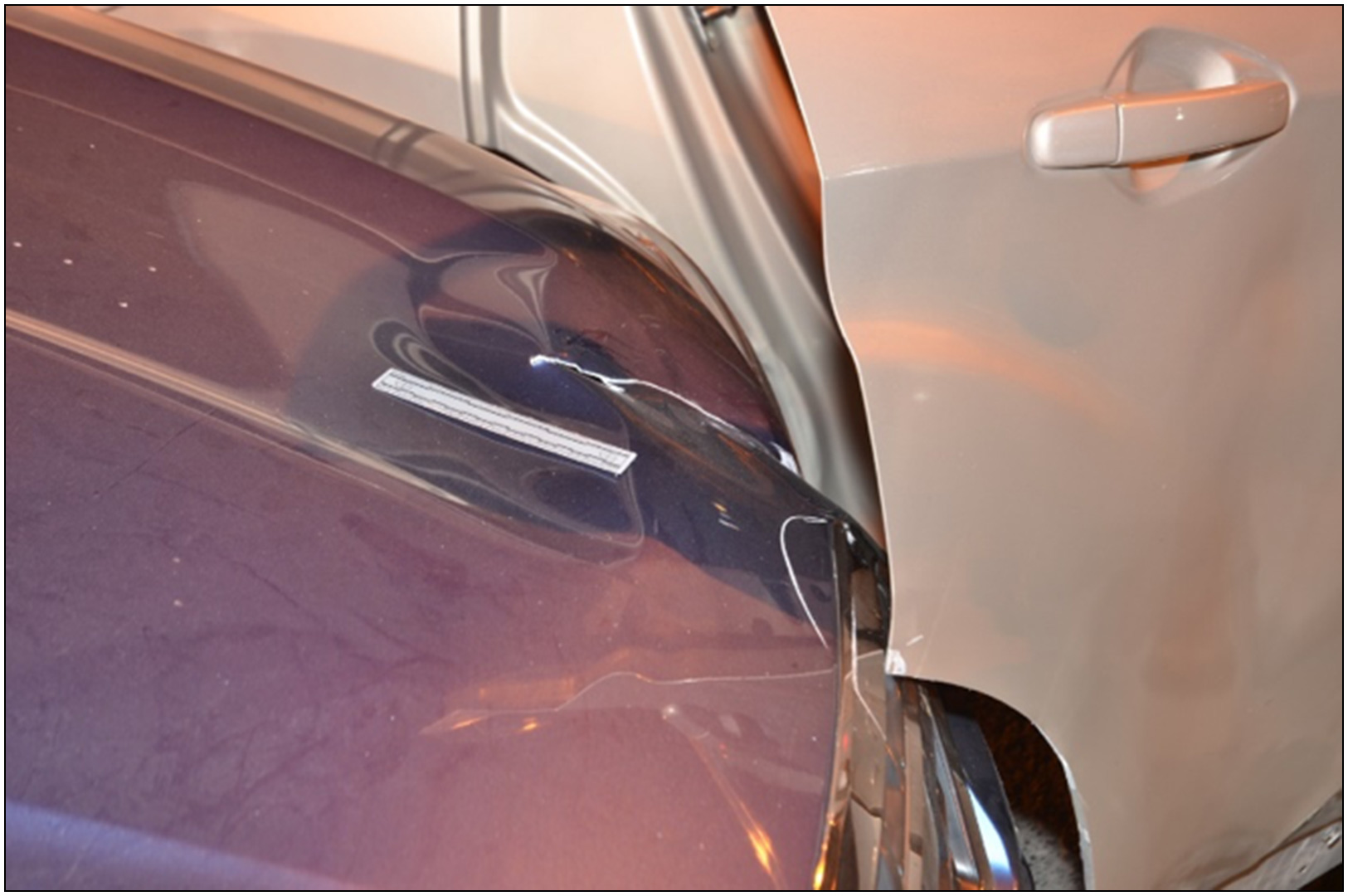
- The right rear door of the Chevrolet Equinox was pushed open further after the initial impact
- The front right tire of the Subaru was lodged against, but did not mount, the west sidewalk, and
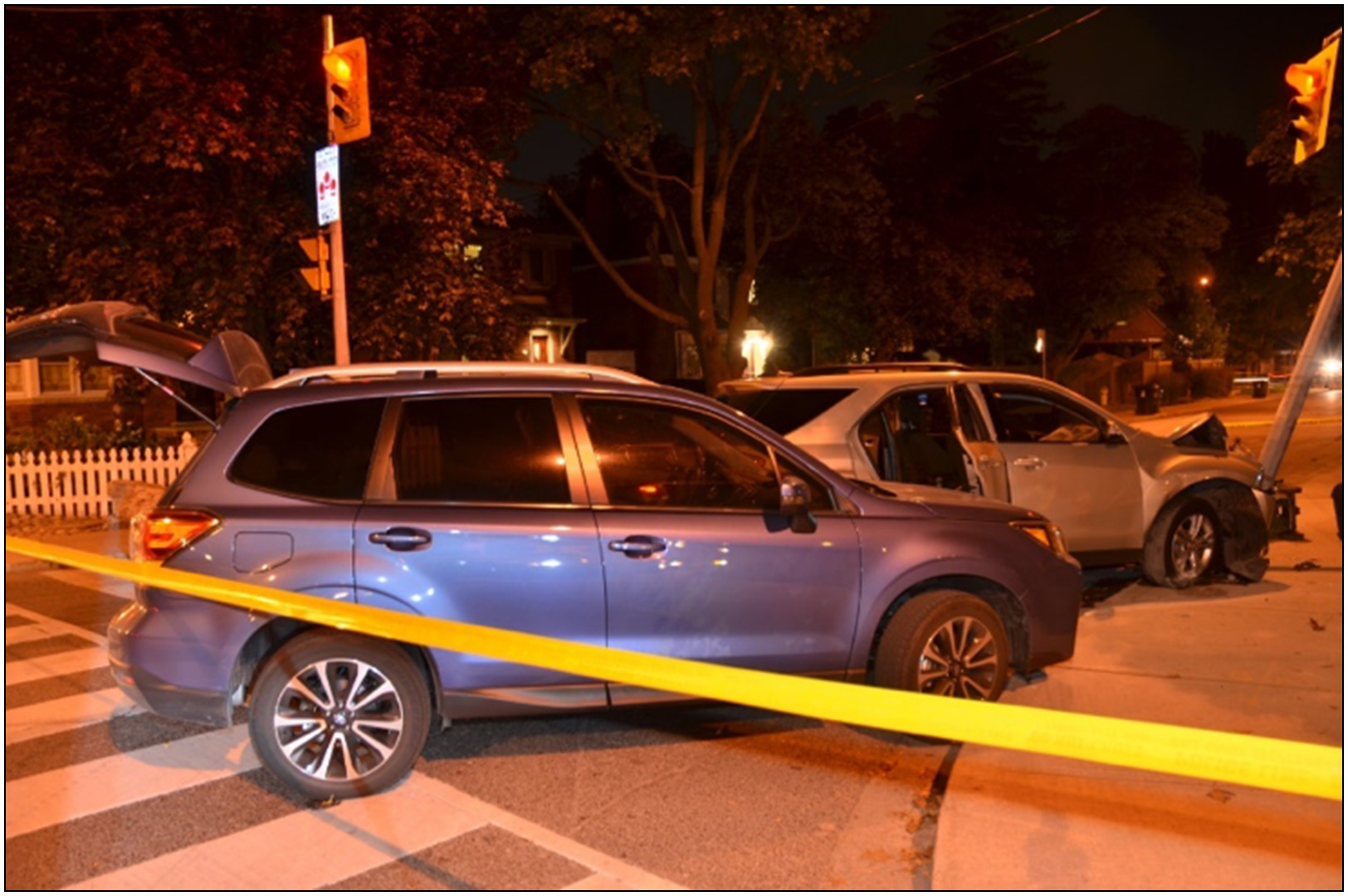
- The Complainant received serious injuries from the Chevrolet Equinox front bumper and hood impact with the traffic signal pole
Video/Audio/Photographic Evidence
The SIU canvassed the area for any video or audio recordings, and photographic evidence, but none was located.
Communications Recordings
Due to the nature of the surveillance, the police transmissions were not recorded.
Materials obtained from Police Service
Upon request, the SIU obtained and reviewed the following materials and documents from the TPS
- Event Details Report
- General Occurrence Report
- Motor Vehicle Accident Report
- Notes of WOÂ #s 1-8 and the SO
- TPS Scene Photos
- Procedure: Suspect Apprehension Pursuit, and
- TPS Collision Reconstruction Field Notes of WOÂ #8
The SIU obtained and reviewed the following materials and documents from other sources:
- Toronto Paramedic Service Ambulance Call Report
- Toronto EMS Incident Reports (x2), and
- Toronto EMS Incident Report Summary
Relevant legislation
Sections 1-3, Ontario Regulation 266/10, Ontario Police Services Act – Suspect Apprehension Pursuits
1. (1) For the purposes of this Regulation, a suspect apprehension pursuit occurs when a police officer attempts to direct the driver of a motor vehicle to stop, the driver refuses to obey the officer and the officer pursues in a motor vehicle for the purpose of stopping the fleeing motor vehicle or identifying the fleeing motor vehicle or an individual in the fleeing motor vehicle
(2) A suspect apprehension pursuit is discontinued when police officers are no longer pursuing a fleeing motor vehicle for the purpose of stopping the fleeing motor vehicle or identifying the fleeing motor vehicle or an individual in the fleeing motor vehicle
2. (1) A police officer may pursue, or continue to pursue, a fleeing motor vehicle that fails to stop
- if the police officer has reason to believe that a criminal offence has been committed or is about to be committed; or
- for the purposes of motor vehicle identification or the identification of an individual in the vehicle
(2) Before initiating a suspect apprehension pursuit, a police officer shall determine that there are no alternatives available as set out in the written procedures of
- the police force of the officer established under subsection 6 (1), if the officer is a member of an Ontario police force as defined in the Interprovincial Policing Act, 2009
- a police force whose local commander was notified of the appointment of the officer under subsection 6 (1) of the Interprovincial Policing Act, 2009, if the officer was appointed under Part II of that Act; or
- the local police force of the local commander who appointed the officer under subsection 15 (1) of the Interprovincial Policing Act, 2009, if the officer was appointed under Part III of that Act
(3) A police officer shall, before initiating a suspect apprehension pursuit, determine whether in order to protect public safety the immediate need to apprehend an individual in the fleeing motor vehicle or the need to identify the fleeing motor vehicle or an individual in the fleeing motor vehicle outweighs the risk to public safety that may result from the pursuit
(4) During a suspect apprehension pursuit, a police officer shall continually reassess the determination made under subsection (3) and shall discontinue the pursuit when the risk to public safety that may result from the pursuit outweighs the risk to public safety that may result if an individual in the fleeing motor vehicle is not immediately apprehended or if the fleeing motor vehicle or an individual in the fleeing motor vehicle is not identified
(5) No police officer shall initiate a suspect apprehension pursuit for a non-criminal offence if the identity of an individual in the fleeing motor vehicle is known
(6) A police officer engaging in a suspect apprehension pursuit for a non-criminal offence shall discontinue the pursuit once the fleeing motor vehicle or an individual in the fleeing motor vehicle is identified
3. (1) A police officer shall notify a dispatcher when the officer initiates a suspect apprehension pursuit
(2) The dispatcher shall notify a communications supervisor or road supervisor, if a supervisor is available, that a suspect apprehension pursuit has been initiated
Section 249, Criminal Code - Dangerous operation of motor vehicles
249 (1) Every one commits an offence who operates
- a motor vehicle in a manner that is dangerous to the public, having regard to all the circumstances, including the nature, condition and use of the place at which the motor vehicle is being operated and the amount of traffic that at the time is or might reasonably be expected to be at that place&hellip
(3)Every one who commits an offence under subsection (1) and thereby causes bodily harm to any other person is guilty of an indictable offence and liable to imprisonment for a term not exceeding ten years
Analysis and director’s decision
On September 21, 2017, at approximately 12:20 p.m., Toronto Police Service (TPS) officers attached to the Mobile Support Unit (MSU) were conducting surveillance on a motor vehicle, a gold/tan coloured Chevrolet Equinox SUV, believed to be involved in a homicide investigation. The team received a request to stop and arrest the occupants of the motor vehicle for murder and the team lead, WO #1, gave the command for a high-risk take-down in the area of Eglinton Avenue East and Laird Drive, when it was safe to do so.
Once the subject vehicle was stopped at a red light, the team boxed the vehicle in with their police vehicles, but the subject vehicle was able to exit the box and accelerated through the traffic light to continue westbound on Eglinton Avenue East. Thereafter, the Equinox became involved in a collision with a light pole, and the driver and one passenger fled from the vehicle, while the front seat passenger was injured, with a possible broken vertebrae, and was transported to hospital.
All of the parties from the Equinox declined to provide statements to SIU investigators. Additionally, the front seat passenger, the Complainant, did not consent to having her medical records released and, as such, her medical injuries, whatever they might be, remain unconfirmed.
During the course of this investigation, as a result of the refusal of the occupants of the motor vehicle to be interviewed, only one civilian witness provided a statement. The subject officer as well as a witness officer were interviewed, and the notes of all nine involved police officers were provided for review. Additionally, investigators had access to the motor vehicle accident report and a collision reconstruction report. Because the team was on an undercover surveillance operation, the police radio transmissions were not on a channel that was being recorded.
CWÂ #1, an independent civilian witness in the area at the time of the incident, described the roadway as level and straight, traffic was significant, and the weather was warm and sunny.
CWÂ #1 observed the subject SUV travelling westbound on Eglinton Avenue East approaching the intersection of Sutherland Drive, where it travelled through the intersection against a red light at a speed in excess of 110Â km/h, and narrowly missed striking another motor vehicle that was travelling north on Sutherland at the time. CWÂ #1 then observed the SUV weaving through traffic and taking a wide left turn onto Rumsey Road at the same high rate of speed, where he then lost sight of the vehicle. CWÂ #1 indicated it was clear to him that this SUV was running from someone.
Approximately 10 to 20 seconds after the SUV drove through the intersection, CW #1 observed more than one vehicle traveling westbound on Eglinton Avenue East at approximately 80 to 90 km/h and pass through the intersection on the green light, without ever catching up to any other vehicles. CW #1 indicated that he assumed that these were police vehicles, although they were unmarked and without lights or sirens activated, and he believed that these vehicles were “chasing†or pursuing the SUV; these vehicles also left his view. He was only able to describe one of these vehicles, which he indicated was black and possibly a pick-up truck or a Ford Explorer.
The SO advised that after the Equinox SUV had managed to evade being boxed in by the surveillance team, WO #1 advised all team members to do a perimeter check for the Equinox. The SO drove her vehicle to the intersection of Eglinton Avenue and Laird Road, where she stopped, and then proceeded when the way was clear. She then continued to drive along Eglinton Avenue, looking up and down intersecting streets for the Equinox. When the SO arrived at Rumsey Road, she observed the Equinox with its front passenger side in collision with a pole and she turned south onto Rumsey Road. As she approached the collision scene, the back door began to open and the SO moved her vehicle forward in order to prevent the door from opening any further and the passenger exiting. The front of the SO’s vehicle made contact with the back passenger door of the Equinox. The SO then parked her vehicle and did not move it. WO #4 and WO #3 then attended and removed the passengers.
The SO estimated that 30 to 40Â seconds had elapsed between the Equinox driving off from the intersection of Laird and Eglinton Avenue and her setting her vehicle in motion to look for the vehicle. The SO advised that she did not pursue the Equinox, but cautiously approached the Laird Road intersection and then proceeded through to look for the Equinox; she estimated her speed at 50Â km/h or less. The SO advised that her intention was to locate the Equinox and then await further direction from WOÂ #1.
WOÂ #1 advised that as soon as the Equinox evaded his team, and he observed it to accelerate through the intersection at Laird Drive and continue on westbound on Eglinton Avenue, he directed the police officers to let it go and not to pursue. He then observed all of the officers get back into their vehicles and he again told them, over the radio, that they were not to pursue, but were to let the Equinox go; they were, however, directed to check side streets for the vehicle.
WOÂ #1 advised that at 12:26Â p.m., he heard over the radio from the SO that she had observed the Equinox in a collision with a pole just east of Eglinton Avenue East at Rumsey Road, which he estimated was approximately half a kilometre from where they had originally tried to box the vehicle in. WOÂ #1 then attended the collision scene and observed that the SO had pinned the rear passenger door closed with her vehicle.
The memo book notes of each of the MSU members involved in the surveillance indicated that after the failed takedown of the Equinox, they searched for the vehicle; none indicated that they were in any way involved in a pursuit.
The Accident Reconstruction report concluded that the critical curve speed (the speed at which a vehicle will lose lateral control on a given roadway curve) for a motor vehicle to turn left from the passing westbound lane of Eglinton Avenue East to southbound Rumsey Road was 37 to 42Â km/h. Having exceeded that speed when making its turn, the Equinox went out of control, mounted the west sidewalk on Rumsey Road, and collided with the traffic signal pole.
The question to be determined, then, is whether or not there are reasonable grounds to believe that the SO’s driving rose to the level of being dangerous and therefore in contravention of s.249(1) of the Criminal Code and did thereby cause bodily harm contrary to s.249(3).
The decision of the Supreme Court of Canada in R. v. Beatty, [2008] 1 S.C.R. 49, indicates that s.249 requires that the driving be dangerous to the public, having regard to all of the circumstances, including the nature, condition and use of the place at which the motor vehicle is being operated and the amount of traffic that, at the time, is or might reasonably be expected to be at that place†and the driving must be such that it amounts to “a marked departure from the standard of care that a reasonable person would observe in the accused’s circumstances.â€
In the absence of any evidence from any of the occupants of the Equinox SUV, I am unable to determine whether or not there was even a belief, mistaken or otherwise, that the police were pursuing the motor vehicle at the time that it collided with the light pole. While the independent civilian witness, CW #1, opined that the unmarked police vehicles were “chasing†the SUV, I find that on his evidence, where he indicated a gap of some 10 to 20 seconds between the time that he saw the SUV pass and the time that he observed the police vehicles going in the same direction at a lesser rate of speed, I am unable to determine if the driving that was observed by CW #1 was before or after the collision of the SUV.
While I have no difficulty accepting as accurate that CW #1 saw a number of police vehicles travelling at a rate of speed which he estimated at 80 to 90 km/h, in the same direction as the Equinox, I am not inclined to believe that these vehicles included the SO, for two reasons: firstly because the SO advised, in her statement, that at the time that she was searching for the Equinox, she was not driving in conjunction with any other police vehicles, and she was driving at a low rate of speed, stopping at each intersection to look down the intersection in search of the Equinox, and secondly, the observation of CW #1, that a black pick-up or SUV was “chasing†the Equinox SUV, does not accord with the motor vehicle being driven by the SO, which was a blue Subaru.
On the evidence there appears to have been a radio transmission by the SO that she had located the Equinox after it had collided with the light pole and that, thereafter, numerous other police vehicles from her team responded to the area, in what, I would have presumed, would have involved some urgency. On the basis of this evidence, I am inclined to accept that the vehicles observed by CWÂ #1 were those of WOÂ #4 and WOÂ #3, and possibly WOÂ #1, who were all responding to the collision scene after having been advised, over the radio, that the SO had located the crashed motor vehicle.
On the limited evidence available on this record, I am unable to find reasonable grounds to believe that the SO was at any time involved in a pursuit of the Equinox SUV, nor that there was any causal connection between her driving and the single vehicle collision between the Equinox and the light pole. I fully accept the evidence of WOÂ #1, which is consistent with the evidence of the SO and the notebook entries of all of the other team members, that immediately upon the Equinox eluding the police takedown efforts, he issued a clear directive that no officer was to pursue, but rather that they were to continue to search for the motor vehicle.
I further note that the SO clearly indicated in her evidence that her intention was to locate the motor vehicle and then to await further direction from WOÂ #1. On the entirety of the evidence, there is nothing to contradict this statement and I have no reason not to accept it as accurate.
I am further inclined to find that the SO was not in pursuit of the Equinox from the following additional facts:
- The SO estimated that there was a gap of some 30 to 40Â seconds between when the Equinox fled from the intersection with Laird Street and when she set her police vehicle in motion to search for its location, which would appear contrary to any effort at a pursuit
- When the SO came upon the accident scene, the collision had already occurred and two of the occupants, including the driver, had already had sufficient time to flee the scene
- The driver had sufficient time to get so far that he could not be located by police
- One of the occupants had sufficient time between the collision and the arrival of the SO to discard a loaded .45Â caliber handgun, which was later found by police in a waste disposal bin on the escape route, and
- The SO was able to place her motor vehicle in a position where it came into contact with the already opened rear passenger door, in order to prevent the passenger exiting the vehicle, upon her arrival
On this evidence, not only do I accept that the SO was not involved in a vehicle pursuit, but I am also unable to find reasonable grounds to believe that her driving was dangerous as defined by the Supreme Court of Canada in R. v. Beatty. In these circumstances, there is no evidence that the driving of the SO interfered with any other traffic and the road and weather conditions were good. Moreover, her contact with the passenger door of the Equinox appears to have been a controlled manoeuvre meant to prevent the escape of any of the other occupants of the motor vehicle rather than one which resulted from her losing control of her vehicle.
Even were I to accept that the SO’s motor vehicle was one of those observed by CW #1 to be travelling at 80 to 90 km/h in the direction taken by the Equinox, which I am not inclined to do, other than their rate of speed, there is no evidence that any of these vehicles was being driven in a manner which could be described as “a marked departure from the standard of care that a reasonable person would observe in the accused’s circumstances.â€
In these circumstances, where police had reasonable grounds to believe that the occupants of the subject vehicle were subject to arrest for murder, there was obviously some urgency in apprehending the vehicle. It is clear, however, that other than attempting to box the motor vehicle in, in order to effect an arrest, no officers pursued the motor vehicle nor did they drive in a manner that was dangerous to the public. WOÂ #1, while in possession of the necessary information by which police could identify the motor vehicle, took what appears to be a calm and level-headed approach in directing his officers not to engage in a police pursuit, but to continue to search for the motor vehicle.
I find, ultimately, that the driver of the Equinox SUV unfortunately chose to try to outrun police and, in doing so, he fled at a dangerous rate of speed and carried out dangerous manoeuvres with no regard for other people using the road or his own passengers. On all of the evidence, the unidentified driver of the Equinox took the turn at the intersection of Eglinton Avenue East and Rumsey Road at too great a speed and lost control of the vehicle, while trying to make good on his escape and he, or she, is solely responsible for the injuries to the passenger.
In conclusion, there is no basis upon which I can find reasonable grounds to believe that the SO, or any police officer involved in the attempted vehicle stop of the Equinox SUV, drove in a dangerous manner and there is no evidence to support a causal connection between the injury sustained by the front passenger of the Equinox and the actions of police. Consequently, there is no evidence upon which I am able to find that any criminal offence was committed by any police officer in these circumstances, and no charges shall issue.
Date: July 12, 2018
Original signed by
Tony Loparco
Director
Special Investigations Unit
Endnotes
- 1) [1] A tire mark from a wheel that is both rotating and slipping: acceleration scuffs, yaw marks, flat-tire marks. [Back to text]
Note:
The signed English original report is authoritative, and any discrepancy between that report and the French and English online versions should be resolved in favour of the original English report.
